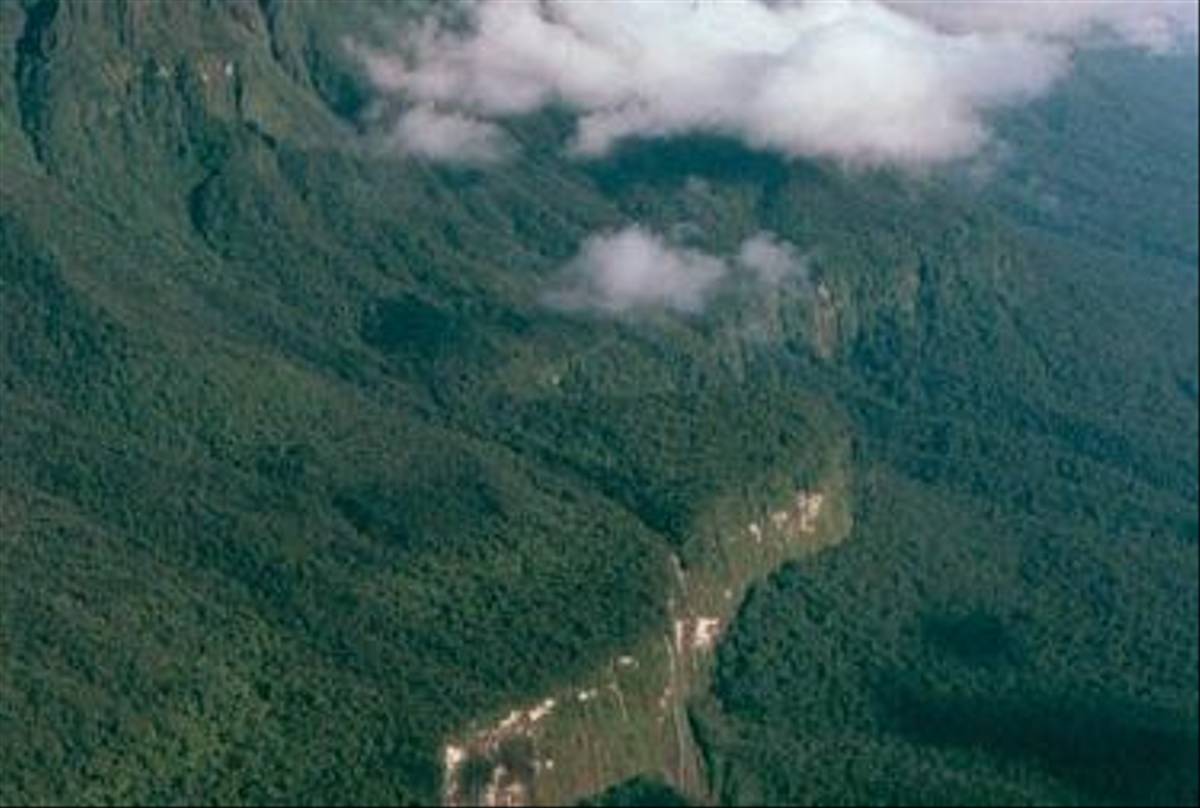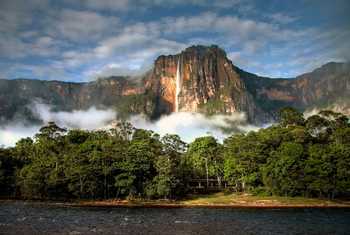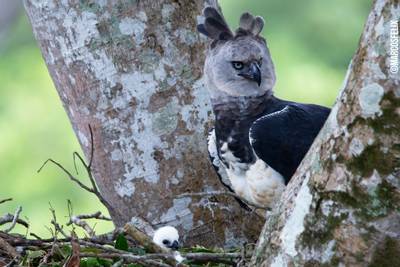Overall I enjoyed the trip. Carlos, our bus driver was very capable and very helpful.
A.J. Norwich



Tour Itinerary and Reports
Can I help you?
Venezuela - Oilbirds, Harpy Eagles & Table Mountains
Tour Code: VEN04A 16-day birdwatching and wildlife holiday visiting the Araya and Paria Peninsulas, Oilbird Cave, Guayana Shield and Table Mountains, with an extension to the Angel Falls.
Highlights
Tour Itinerary and Reports
Can I help you?
Quick Enquiry
Summary
On this birding tour we will visit Sir Arthur Conan Doyle's 'Lost World' – that unique region known as the Guiana Shield where impressive, sheer-sided mesas or plateaux rise hundreds of metres above the landscape. We begin our holiday, though, on the coast, searching the salt flats for flamingoes and coastal endemics. Cloudforest specialities are then our goal on the Paria Peninsula – Columbus’ point of arrival in mainland America – before we head, via a spectacular Oilbird cave, to 'The Lost World' region (a UNESCO World Heritage Site) in search of Harpy Eagles and a host of other birds unique to the area. The wonderful family-run Barquilla de Fresa Lodge is an unforgettable place to end the tour.
- Experience unique 'Lost World', Table Mountain scenery
- Visit the world-famous Oilbird cave, home to thousands of these curious birds
- Combine Paria Peninsula endemics with dozens of Table Mountain specialities
- Search for Harpy Eagle, the world’s most powerful raptor, where breeding pairs reach highest density
- Cotingas galore, from Bellbirds to Cock-of-the-Rocks and Capuchinbirds
- Enjoy toucans, parrots and hummingbirds and more
Grading
Walking is fairly easy, except for two (optional) longer hikes up Cerro de Humo and Cerro Negro.A 16-day birdwatching and wildlife holiday visiting the Araya and Paria Peninsulas, Oilbird Cave, Guayana Shield and Table Mountains, with an extension to the Angel Falls.
Home to 1,400 different bird species, Venezuela boasts the sixth richest avifauna on Earth. To sample this wealth of birdlife, bird tours have traditionally focused on the north of the country; this holiday, however, will explore the little-known southern region which forms the core of the world’s largest tropical wilderness area, the territory idealised in Conan Doyle’s ‘The Lost World’s and Hudson’s ‘Green Mansions’s. Here we will focus on the birds of the famous tepuis, or table mountains, together with the lowland forests which collectively comprise the ancient Guayana Shield. By adding a visit to the Oilbird Cave and the Paria Peninsula (the point at which Columbus finally landed on mainland America), we offer you an unbeatable wildlife tour of eastern Venezuela!
We begin on the Caribbean coast, with a night in an inn not far from the airport before flying on, the following morning, to the north-east of the country. Here we will spend the rest of the day exploring the strange, arid moonscape of the Araya Peninsula, looking for such dry country specialities as Yellow-shouldered Parrot, Buffy Hummingbird, Glaucous Tanager and Vermilion Cardinal, as well as American Flamingo, Scarlet Ibis and a wide range of waders. An hour’s drive onwards takes us to Finca Vuelta Larga, a German-owned conservation ranch where we will look for the diminutive Black-dotted Piculet, White-chested Emerald and the stunning Crimson-hooded Manakin, together with a variety of both open country and wetland birds.
Cerro de Humo (Smoke Mountain), on the Paria Peninsula, is our fourth day’s destination. Here we hope to rendezvous with the Paria endemics — Scissor-tailed Hummingbird, White-tailed Sabrewing, White-throated Barbtail, Paria Whitestart and Venezuelan Flowerpiercer — and also try to find such birds as Venezuelan Parakeet, the local form of Slate-crowned Antpitta and Handsome Fruiteater before we drive on to Caripe. This site is best known as the location of the Oilbird Cave first described by Humboldt, and on one of our two evenings here we will witness the remarkable sight of thousands of Oilbirds leaving their cave. Whilst in Caripe we will also take a hike up Cerro Negro in search of the endangered endemic, Grey-headed Warbler, and Venezuelan Sylph.
Bidding farewell to Venezuela’s north-east, we now set our sights on an entirely different avifauna. Our lodge in the Imataca Forest Reserve is best known as the access point to the world’s top region for breeding Harpy Eagles. Here we have arguably the best chance anywhere in its range of finding this, the world’s largest eagle. The reserve is also home to a plethora of superb lowland rainforest species and we will spend the next three nights here in search of them. Amongst the hundreds of species that we could see here, Marail Guan, Black Curassow, many parrots (including Caica and Red-fan Parrot), Black-necked and Green Aracaris, Guianan Toucanet, Black-spotted Barbet, Curve-billed Scythebill, Fasciated and Great Antshrikes, a host of antbirds (such as Rufous-throated, Ferruginous-backed and the spectacular White-plumed), antwrens (including Todd’s, Spot-tailed, Long-winged and Grey) and Pompadour Cotingas are just a few!
Reluctantly dragging ourselves away from this rainforest bonanza, we next drive southwards towards the tepuis, where we will spend our final four nights in the wonderful, family-run Barquilla de Fresa lodge. The owners are excellent hosts and know exactly what we have come for, their lodge being located in the fabulous lowland forests at the base of the Sierra de Lema escarpment — home to Capuchinbirds and other cotingas. After each long day’s birdwatching in the lowland rainforests, and on the wall of the table mountain above the lodge, we will no doubt return to relax at the lodge with a cold drink and to enjoy the Crimson Topaz at the feeders, the Paradise Jacamars in the garden and the Swallow-winged Puffbirds nesting by our cabins. However, our main targets will be the 30 or more tepui endemics, amongst them Tepui Tinamou, Tepui Parrotlet, Tepui Goldenthroat and so on; not to mention the Tepui Spinetail, Antpitta, Brush-finch, Whitestart, Greenlet and Mountain-grackle! Blue-cheeked Parrot, Guianan Cock-of-the-rock, Bearded and White Bellbirds and such rare birds of prey as Orange-breasted Falcon and Black-faced Hawk will be amongst other species that we hope to see in this unforgettable prehistoric-looking landscape with its sweeping vistas of unbroken rainforest and sheer tepui walls. It is little wonder that this area is a UNESCO World Heritage Site! A marvellous spot at which to conclude our tour!
Those of you wishing to stay on may opt to take our 3-day extension to visit the Angel Falls, the world’s highest waterfall. Our lodge lies alongside the stunningly beautiful Carrao River, with a series of waterfalls close by. One day will be devoted to travelling up-river in canoes to visit the base of the Angel Falls.
Outline Itinerary

What's Included?
- Flights
- Accommodation: Birding lodges and small inns, most with private facilities.
- Food: All included in the price.
Reviews
-
-
Thank you for this tour... everything worked out well. We were more than pleased with the expertise of our charming guide Cecilia Herrera.
B.P. -
Great trip, very successful. The sighting we had of White-plumed Antbird at an ant swarm was outstanding.
D.B.
Why Naturetrek?
At Naturetrek we craft expertly-guided group and tailor-made wildlife holidays and cruises to all seven continents. On one of our holidays, you can be assured that our passionate team will enable you to experience and enjoy the best of the world's wildlife and natural spectacles in as comfortable and rewarding a manner as possible, caring as best we can for the environment in the process. We are proud to provide:
- The widest choice of wildlife holidays worldwide
- Tours managed and led by naturalists, for naturalists
- Outstanding value and exceptional customer service
Furthermore, as a Naturetrek client, our office team are always to on hand to help you – so if you have any queries about your holiday, whether before or after you have booked, we will be delighted to answer them on the phone. Please just give our team a call!
Related articles
Harpy Eagles are truly magnificent and highly sought birds. Each Harpy Eagle pair needs several square miles of undisturbed forest to thrive and breed, hunting their established range continuously to feed themselves and offspring. In this article, read recent Harpy Eagle nest updates from Panama and Brazil.



 Loading search...
Loading search...























